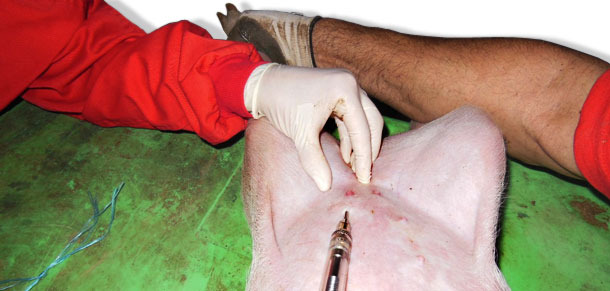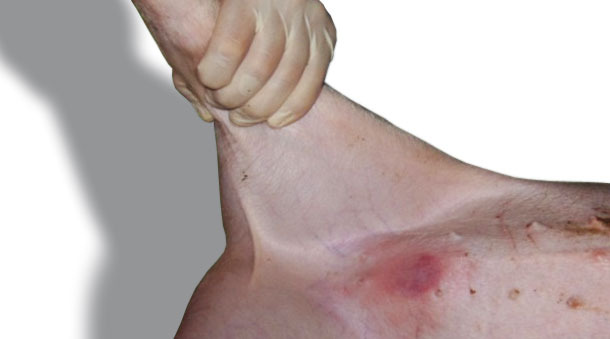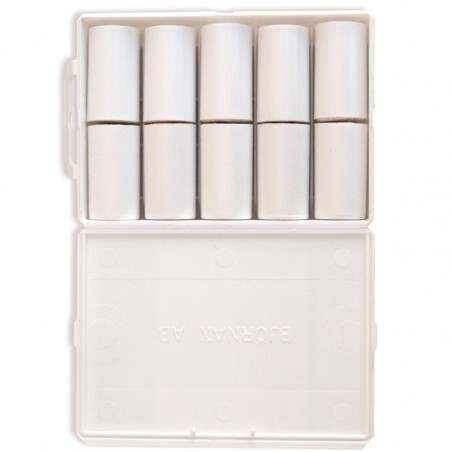In practical terms we can describe 'compliance' as the correct administration or the monitoring of the rules for the use of a product or a prescription. On the other hand, the acronym DTH is used for naming a hypersensitivity reaction known as delayed hypersensitivity or type IV hypersensitivity. What has a hypersensitivity reaction got to do with a correct vaccination guideline against PCV2? It may be that our first answer is 'little or nothing at all'. Nevertheless, it has a lot to do with it, as we will explain in this article.


Photo 1. Intradermal inoculation of the antigen
The DTH test is very familiar in the veterinary world because it is used for diagnosing tuberculosis. Sure enough, the tuberculin test is well-known, and it is based on the hypersensitivity reaction shown by an animal against an antigen if it has previously come into contact with it. The intradermal inoculation of the inactivated tuberculosis bacillus or of a purified protein fraction of the bacillus causes a hypersensitivity reaction that shows up after some hours on the inoculation point and that is characterized by a thickening, oedema, erythema or induration of the skin. For years, it has been well-known that this test is related to the cell-mediated immunity, but nevertheless it is used for detecting infected animals and to help in the eradication of tuberculosis. So, how can it be of help for the assessment of the compliance of the vaccination against PCV2? It is very easy: the porcine circovirus type 2, as a viral agent, is an intracellular pathogen, and as such it is able to cause an adaptive cell-mediated immune response. In fact, the vaccines against PCV2 trigger, under normal conditions, a humoral and cell-mediated response against this virus.

Photo 2. Typical reaction (erythema) seen 24 hours after the inoculation in the skin of the abdomen.
The following step is: How can we implement the DTH test for compliance purposes? It is very easy: we only have to inoculate PCV2 antigen intradermally in the suspicious animals (those that we wish to know if have been vaccinated or not) at a suitable interval after the presumed vaccination date. As the vaccination against circovirus is usually carried out at 3-4 weeks of age, we will have to let at least 3 weeks go by to perform the test. Because this test may yield a positive response (although with a lesser magnitude) in animals with maternal cellular immunity, we recommend to delay it until 7-9 weeks of age, this is 4-6 weeks after the vaccination. This is not a test with an individual but a collective value, and due to this it is advised to perform it on some 10-15 animals per age group, depending on the batch size. The results are obtained after some 24 hours, and a qualitative (positive/negative) or a quantitative (diameter of the reaction) reading may be made. The reaction produced (photo 2), that may be a reddened or indurated area, coupled with oedema or not, depends on the area of skin where the inoculation is carried out and on the device used for the inoculation of the antigen. In piglets of 7-10 weeks of age it is better to innoculate the antigen in the abdomen, between the last and the penultimate teat. It is not necessary to inject a tranquilizer, because it is a quick, safe and harmless procedure. Its great advantage is that it can be performed on the field without having to resort to a laboratory. To inoculate the antigen it may be enough with an insulin syringe, but there are other alternatives. When interpreting the results of this test we must bear in mind the following:
- The sensitivity is of around 80-85%. This means that it is normal that there are 2-3 animals in the group of 10-15 pigs that do not show a reaction, without this meaning that they have not been vaccinated, although the normal reaction rate is usually 100%.
- The lack of reaction does not imply that the animals are unprotected, because the test, as we have said, detects the cell-mediated immunity, and the protection depends not only on the cell-mediated immunity but also on the humoral immunity (neutralizing antibodies).
This test is of interest for checking the carrying out and/or the quality of the vaccination in cases such as the entrance of piglets on a farm for their fattening.







